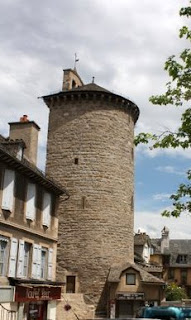 |
| Basilica in Place Urbain V |
...through the city of Mende. But, before we set off, I probably need to supply a few facts and
a bit of history.
Sitting on the
southern edge of the Massif Central, Mende is the préfecture – principal
administrative city - for the département of Lozère in the recently-formed Occitanie region of France. With a population of
around 12,000 and an area of 14 square miles, the town sits in the high valley
of the Lot about 30k due west of Mont Goulet and the source of the river. At an altitude of 700m, living here is bit
like living near the top of Cross Fell in the Pennines, but with better
weather.
There has been
habitation on this spot for over 2,000 years and the history is varied and
complex. Raided and sacked on numerous
occasions – not least during the Religious Wars - Mende has survived to be the
prominent town that it is, centred around it’s old medieval foundations with
the modern city surrounding it. In the
middle ages, Mende became a centre of culture and civilisation, a focal point
for trade, art and craftsmen with a notoriety that stretched as far north as the cities of Moulins and Vichy.
We begin our visit in
Place Urbain V with a look at the cathedral.
The Basilica of Notre-Dame-et-St-Privat is striking because of its
mismatched towers. Begun in the 14th
Century, under the auspices of the then Pope Urbain V, the cathedral was
partially destroyed during the Religious Wars of the 16th Century –
hence the odd towers. The original bell
‘Non Pareille’, then the largest bell ever to have been cast, was melted down
for bullets so that Capitaine Mathieu Merle and his Huguenot soldiers could
continue the fight. With more than 10
interior chapels, Aubusson tapestries in rainbow colours and the detailed
vaulting, this is a truly magnificent example of the changing architecture over
the centuries.
 |
| Old streets of Mende |
Out in the sunshine
again and we are going to take a right, past the préfecture building – more of
that later – into the narrow streets of the old medieval town. With houses of three and four stories high,
so close that neighbours could almost shake hands above the cobbles as they
reach out of their open windows, the shade is welcome and necessary in the
mid-day heat. This part of the city
became the home to hundreds of Jewish traders and remained their domain right
up until the 20th century.
And it is one of these streets that I will be using as the location for
a business for one of my characters in my next novel.
 |
| Tour des Pénitents |
If you follow me into
the bright white heat of Place au Blé you will see one of the vestiges of the
old fortifications of the town – Tour des Pénitents. Originally constructed in the 12th century and then
rebuilt after the Hundred Year’s War, it survived the deliberate destruction of
all of the ramparts in 1768. In 1721,
the plague moved rapidly north from Marseille to Mende and took the lives of
over 1,000 people in little more than a year.
The subsequent tearing down of the city walls was instituted as a health
measure to enable fresh air to blow into the town.
From here it’s a short
walk along rue de l’Abbaye to the préfecture building, which stands
magnificently beside the cathedral. It
was in this building, during the 1939/45 war that the Mayor at the time, Henri
Bourrillon, defied the Vichy regime.
Bourrillon objected to the internment camp that was built close to the
town and, his words, actions and further objections caused him to be removed
from his position of authority in 1941.
Henri took this in his stride and joined the Resistance and Mende, and
some of its bravest people, took on a new role in support of the Jewish
community within the city.
And the city of Mende features in both of my books, Messandrierre and Merle
No comments:
Post a Comment